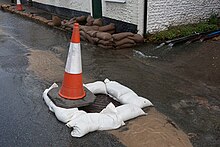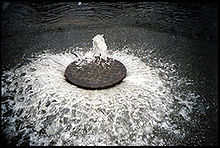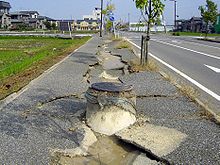
Sewerage is the infrastructure that conveys sewage or surface runoff using sewers. It encompasses components such as receiving drains, manholes, pumping stations, storm overflows, and screening chambers of the combined sewer or sanitary sewer. Sewerage ends at the entry to a sewage treatment plant or at the point of discharge into the environment. It is the system of pipes, chambers, manholes or inspection chamber, etc. that conveys the sewage or storm water.
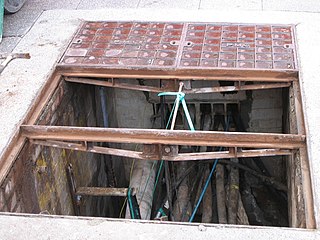
A manhole is an opening to a confined space such as a shaft, utility vault, or large vessel. Manholes are often used as an access point for an underground public utility, allowing inspection, maintenance, and system upgrades. The majority of underground services have manholes, including water, sewers, telephone, electricity, storm drains, district heating, and gas.

A sanitary sewer is an underground pipe or tunnel system for transporting sewage from houses and commercial buildings to a sewage treatment plant or disposal.
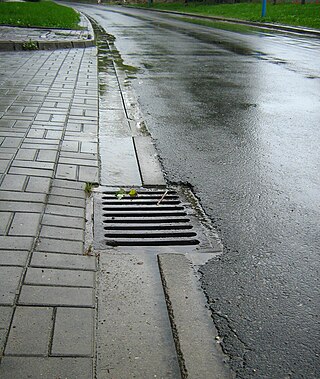
A storm drain, storm sewer, surface water drain/sewer, or stormwater drain is infrastructure designed to drain excess rain and ground water from impervious surfaces such as paved streets, car parks, parking lots, footpaths, sidewalks, and roofs. Storm drains vary in design from small residential dry wells to large municipal systems.
A grinder pump is a wastewater conveyance device. Waste from water-using household appliances flows through the home’s pipes into the grinder pump’s holding tank. Once the wastewater inside the tank reaches a specific level, the pump will turn on, grind the waste into a fine slurry, and pump it to the central sewer system or septic tank.

A combined sewer is a type of gravity sewer with a system of pipes, tunnels, pump stations etc. to transport sewage and urban runoff together to a sewage treatment plant or disposal site. This means that during rain events, the sewage gets diluted, resulting in higher flowrates at the treatment site. Uncontaminated stormwater simply dilutes sewage, but runoff may dissolve or suspend virtually anything it contacts on roofs, streets, and storage yards. As rainfall travels over roofs and the ground, it may pick up various contaminants including soil particles and other sediment, heavy metals, organic compounds, animal waste, and oil and grease. Combined sewers may also receive dry weather drainage from landscape irrigation, construction dewatering, and washing buildings and sidewalks.
The United States Environmental Protection Agency (EPA) Storm Water Management Model (SWMM) is a dynamic rainfall–runoff–subsurface runoff simulation model used for single-event to long-term (continuous) simulation of the surface/subsurface hydrology quantity and quality from primarily urban/suburban areas.

First flush is the initial surface runoff of a rainstorm. During this phase, water pollution entering storm drains in areas with high proportions of impervious surfaces is typically more concentrated compared to the remainder of the storm. Consequently, these high concentrations of urban runoff result in high levels of pollutants discharged from storm sewers to surface waters.
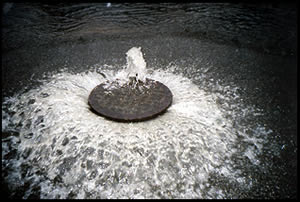
Sanitary sewer overflow (SSO) is a condition in which untreated sewage is discharged from a sanitary sewer into the environment prior to reaching sewage treatment facilities. When caused by rainfall it is also known as wet weather overflow. Causes of sanitary sewer overflows include: Blockage of sewer lines, infiltration/Inflow of excessive stormwater into sewer lines during heavy rainfall, malfunction of pumping station lifts or electrical power failure, broken sewer lines. Prevention of such overflow events involves regular maintenance and timely upgrades of infrastructure.

A vacuum sewer or pneumatic sewer system is a method of transporting sewage from its source to a sewage treatment plant. It maintains a partial vacuum, with an air pressure below atmospheric pressure inside the pipe network and vacuum station collection vessel. Valves open and reseal automatically when the system is used, so differential pressure can be maintained without expending much energy pumping. A single central vacuum station can collect the wastewater of several thousand individual homes, depending on terrain and the local situation.

A grease trap is a plumbing device designed to intercept most greases and solids before they enter a wastewater disposal system. Common wastewater contains small amounts of oils which enter into septic tanks and treatment facilities to form a floating scum layer. This scum layer is very slowly digested and broken down by microorganisms in the anaerobic digestion process. Large amounts of oil from food preparation in restaurants can overwhelm a septic tank or treatment facility, causing the release of untreated sewage into the environment. High-viscosity fats and cooking grease such as lard solidify when cooled, and can combine with other disposed solids to block drain pipes.
A Buchan trap is a device fitted in a domestic sewer pipe to prevent odours entering the pipe from the public sewer and permeating the house, a common problem before individual plumbing fittings were separately trapped. The trap is made from fireclay and uses a water seal to prevent air passing from the sewer to the pipe. Waste flows from the house through a U-bend in the trap. This means that there is always water in the pipe preventing the passage of anything from the other direction. The device is a large clay U-bend with an air-inlet/access point on the 'house' side. It is located below the ground level, but can be accessed through the air-inlet and sometimes a rodding hole.

Sewage is a type of wastewater that is produced by a community of people. It is typically transported through a sewer system. Sewage consists of wastewater discharged from residences and from commercial, institutional and public facilities that exist in the locality. Sub-types of sewage are greywater and blackwater. Sewage also contains soaps and detergents. Food waste may be present from dishwashing, and food quantities may be increased where garbage disposal units are used. In regions where toilet paper is used rather than bidets, that paper is also added to the sewage. Sewage contains macro-pollutants and micro-pollutants, and may also incorporate some municipal solid waste and pollutants from industrial wastewater.
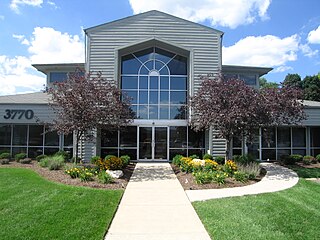
H.R. Gray is an American construction management company specializing in construction management, cost estimating, project management, scheduling, claims avoidance, and ADA compliance. Engineering science and contract document knowledge is used to decide construction claims or litigation. To date, H.R. Gray has worked on several projects totaling more than $2 billion, with the majority of their $4 to 5 million in annual revenue coming from public works projects.
Infiltration/Inflow is the process of groundwater, or water from sources other than domestic wastewater, entering sanitary sewers. I/I causes dilution in sanitary sewers, which decreases the efficiency of treatment, and may cause sewage volumes to exceed design capacity. Although inflow is technically different from infiltration, it may be difficult to determine which is causing dilution problems in inaccessible sewers. The United States Environmental Protection Agency defines the term infiltration/inflow as combined contributions from both.

The Parshall flume is an open channel flow-metering device that was developed to measure the flow of surface water and irrigation flow. A fixed hydraulic structure, the flume is used to measure volumetric flow rate in industrial discharges, municipal sewer lines, and influent/effluent flows in wastewater treatment plants. The Parshall flume accelerates flow through a contraction of both the parallel sidewalls and a drop in the floor at the flume throat. Under free-flow conditions, the depth of water at a specified location upstream of the flume throat can be converted to a rate of flow. Some states specify the use of Parshall flumes, by law, for certain situations.
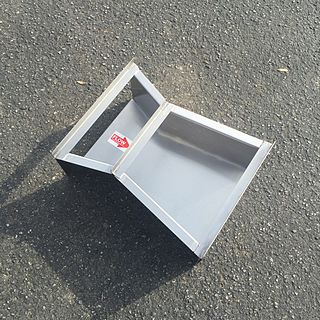
The Cutthroat flume is a class of flow measurement flume developed during 1966/1967 that is used to measure the flow of surface waters, sewage flows, and industrial discharges. Like other flumes, the Cutthroat flume is a fixed hydraulic structure. Using vertical sidewalls throughout, the flume accelerates flow through a contraction of sidewalls until the flow reaches the "throat" of the flume, where the flow is then expanded. Unlike the Parshall flume, the Cutthroat flume lacks a parallel-walled throat section and maintains a flat floor throughout the flume.
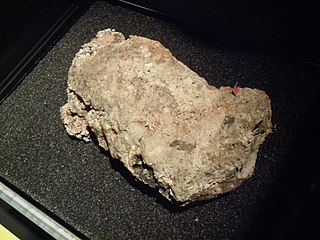
A fatberg is a rock-like mass of waste matter in a sewer system formed by the combination of flushed non-biodegradable solids, such as wet wipes, and fat, oil, and grease (FOG) deposits. The handling of FOG waste and the buildup of its deposits are a long-standing problem in waste management, with "fatberg" a more recent neologism. Fatbergs have formed in sewers worldwide, with the rise in usage of disposable cloths. Several prominent examples were discovered in the 2010s in Great Britain, their formation accelerated by aging Victorian sewers. Fatbergs are costly to remove, and they have given rise to public awareness campaigns about flushable waste.

Packaged metering manholes (PMMs) are an outgrowth of the fiberglass manholes developed in the 1960s. Packaged metering manhole factories integrate a primary device (typically a flume or weir) into a fiberglass manhole.

A gravity sewer is a conduit utilizing the energy resulting from a difference in elevation to remove unwanted water. The term sewer implies removal of sewage or surface runoff rather than water intended for use; and the term gravity excludes water movement induced through force mains or vacuum sewers. Most sewers are gravity sewers because gravity offers reliable water movement with no energy costs wherever grades are favorable. Gravity sewers may drain to sumps where pumping is required to either force sewage to a distant location or lift sewage to a higher elevation for entry into another gravity sewer, and lift stations are often required to lift sewage into sewage treatment plants. Gravity sewers can be either sanitary sewers, combined sewers, storm sewers or effluent sewers.







